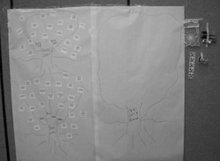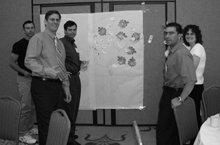Playing the Game Organize your participants so that 4 to 10 people are at each tree. Having too many people at a single tree prevents good group interaction. It is ideal if you can allocate one observer to each tree. During your explanation remind participants that the shape of the tree represents growth over time. Existing features should therefore go near the trunk, as they are the oldest. The next closest leaves represent features to add in the near term. Leaves on the outer edges of the tree, at the edge of the canopy, and even beyond are considered longer term. You can make this even more explicit by putting time frames or release identifiers on the growing canopy. Allow each group time to present their results to the entire group. Encourage other participants to ask questions about how the leaves in the tree were organized. Try not to worry about the tree becoming unbalanced. It might happen, but my experience is that participants tend to organize features according to the shape of the tree you've given to them. In one game, a participant remarked to another, "We've got to move some features around, as the tree is becoming lopsided," and another remarked, "We're cramming too many features into this releasewhat can we push out?" Of course, the tree your customers create might not match the tree that they started with. If that happens, pay attention to what your customers are trying to tell you. Encourage participants to group leaves or draw lines between leaves to clarify relationships among features. As described in the sidebar about the PMEC conference, one participant drew a heart around a pair of leaves to signify that she "loved" these features. Using Multiple Trees at the AIPMM PMEC 2006 Conference The Association for International Product Marketing and Product Management (www.aipmm.com) used multiple trees to gather feedback from attendees at their 2006 Product Management Educational Conference. In this photo from the conference you can see three trees (see Figure 2.4). The top left tree represents the 2005 conference, which had two primary tracks (represented as two branches): Product Management and Product Marketing. The 2006 conference tree is shown below the 2005 tree and has four branches representing the phases of the product life cycle: Plan, Build, Launch, and Sustain. Tutorials, keynotes, and activities were represented as leaves that could be moved to the new tree. Figure 2.4. Using Multiple Product Trees 
The 2007 tree is shown to the right. As you can see, it allowed for a completely open-ended exploration of the next conference. PMEC attendees could create their own branches, move leaves from the 2005 and 2006 trees to the 2007 tree, and add new leaves (representing new topics they'd like to see addressed at the 2007 conference). There is also a package of leaf shaped foil stickers, which attendees used to indicate strong support for a proposed topic. Attendees were also encouraged to personalize their trees, adding business cards or other mementos of their time at the conference. PMEC participants quickly got into the game, as you can see in Figure 2.5. Groups quickly formed, mostly from people who shared the same lunch tables. These groups moved the leaves representing the talks that they liked most from the 2005 and 2006 conferences to the 2007 conference, and, as you can see, they added several new ideas for talks by adding new leaves. Participants added business cards and one even drew a heart around two leaves that she particularly "loved."[3] Figure 2.5. Playing Prune the Product Tree at PMeC 
Therese Padilla, Executive Director of AIPMM, posted her experience of the event into the Enthiosys Forum at www.innovationgames.com. Here is an excerpt from her post: "Once the trees were placed around the room and the conference attendees began to add ideas, it was gratifying to scan the room and visually see all the new ideas that were placed on the trees. We have begun to gather the results, but already we have three exceptional ideas for our next conference. This is a wildly different approach to conference activities. This form of engagement energized the attendees and really involved them. This was the first time in all our conferences that we witnessed this level of participation and creativity from attendees. Attendees really took an interest in the event and were encouraged to make the event their own. This was the best way to ask them to design PMEC the way they wanted to see the content." |
[3] This is an example of when it was good that an observer spoke; by asking the meaning of the "heart," the observer was able to confirm that the participant "loved" the talks.
Letting Customers Pick the Tree Shape You can make this game even more open ended by giving customers a list of current features and several different kinds of leaves (or just blank index cards) and asking them to select both the tree and structure of the leaves and branches. You'll find that although this approach takes quite a bit more time, you'll gain an even richer and deeper understanding of your customers as you listen to them explain why they chose a particular tree and how the features of your product relate to this tree. This approach can also provide more insights into the larger product ecosystem, as customers often draw additional items along with their trees. |
Encourage participants to personalize their trees. Although not required, the game can be more fun when people add additional art (birds, grass, sun), tape business cards to the trunk, or write their name on the back of their leaf suggestions. Don't forget about the root system. Encourage participants to write information into the root system. Try to leave the trees up as long as possible. If you're playing this game over a multiday event, put the trees up on the first day and leave them up as long as possible. You'll find that participants continue to play the game as they think of more leaves and discuss the game with other participants. |

